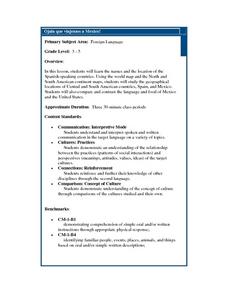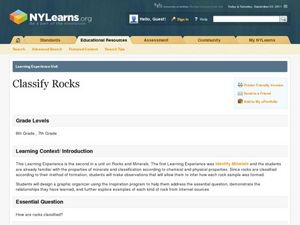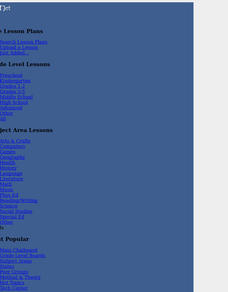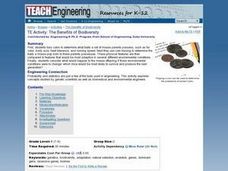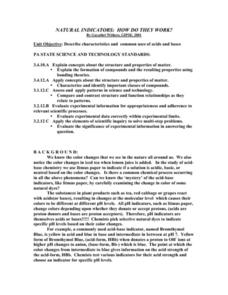Curated OER
Dance Tag
Students get moving instantly while reviewing already learned dance movements, the levels concept, and the self-space concept.
Curated OER
Ojala que viajemos a Mexico!
Students research the names and locations of Spanish speaking countries throughout the world. They use a world map to become familiar with the locations of these countries and use the Internet to conduct further research. They sing...
Curated OER
Heart Disease Prevention
Fourth graders get into groups and brainstorm ways to obtain physical activity and different healthy foods to eat. They then develop and write and individual plan for healthy living and commit to enforcing their plan for a minimum of one...
Curated OER
Electromagnets
Students are introduced to the relationship between electricity and magnetism. Using a compass, they observe and record the effects of placing the object near magnetic fields and electric currents. They also experiment using a steel and...
Curated OER
Science: Birds in Flight
Young scholars identify and examine adaptations in birds that enable them to fly. They conduct Internet research to relate these adaptations to the physics of flight. Students observe birds in flight and describe their behavior and...
Curated OER
Modern Issues
Ninth graders examine how modern issues of the world affect their lives. They listen to a lecture about the differences between developed and developing countries, act out physical representations of charts and pictures on the overhead,...
Curated OER
Planet Oit!
Twelfth graders use this game to find minerals given rocks and outcrops in a plausible (but not real) geologic setting. They play without outside encouragement for hours as the world is fun to explore and the scoring system encourages...
Curated OER
Fish Haunts
Middle schoolers examine some of the different ecosystems that fish live in. While doing this they identify the species of fish and the ecological conditions needed for survival. Students use research resources to make fish cards that...
Curated OER
Pedestrian Safety
Students review the concepts of pedestrian safety. Individually, they draw a picture of themselves doing an activity they enjoy noting the rules of safety. After sharing their picture, they discuss the benefits of being safe during...
Curated OER
Classify Rocks
Young scholars classify different types of rocks. In this earth science instructional activity, students test different rock samples and construct a chart to record observations. They create a concept map that answers essential questions.
Curated OER
Sacred Giving- Why?
Students define the Jewish concept of tzedakah. For this religious lesson, students read portions of the Torah and discuss the meaning of tzedakah. Students visit a Jewish Community Center.
Curated OER
Weather
Students participate in a variety of mini-lessons including experiments, literature readings, physical education components, music, data gathering and recording and more to expose them to several themes of weather; i.e. water cycle,...
Curated OER
Color Principles - Hue, Saturation, and Value
Students identify different color models and the application of the color theory. They create different visualizations that compare color models.
Curated OER
Sink or Float Water Play Activity
Students experiment with different objects to see if they sink or float. They can also choose certain colored items if more review is necessary.
Curated OER
The Benefits of Biodiversity
Students examine the concept of biodiversity. They toss coins to determine what traits mouse parents have and the babies traits as well. They predict what would happen to the baby mice if the traits of the parents were different.
Curated OER
Properties of Matter: "Sink or Swim"
Third graders recognize that different materials have different properties which can be observed such as texture and bouyancy, and compare and contrast, through observation, ability of some objects to float because of action of...
Curated OER
What Can We Lose? What Do We Lose as we Gain Force With A Lever?
Third graders view a demonstration of a teeter totter as a basis for assessing pre-knowledge of a lever. They create a KwL chart. Students work in small groups to conduct a variety of experiments. The first requires students to tie books...
Curated OER
Natural Indicators: How Do They Work?
Pupils describe characteristics and common uses of acids and bases. They describe the role of natural indicators in the chemistry of acids and bases after testing and making observations on a variety of plant extracts. Students observe...
Curated OER
Using Blood Tests to Identify Babies and Criminals
Students solve a crime by matching a suspect's blood type to physical evidence collected at the crime scene. In this forensic science instructional activity, students identify the different blood types. They explain how blood tests work.
Curated OER
Conductors, Insulators, and Semiconductors
Students will investigate the differences in conductivity of materials, design a variety of complete circuits, and observe the differences between the manner in which light is produced in an incandescent light bulb and an LED.
Curated OER
Water Ph
Eighth graders study the concepts of acids, bases, salts and neutralization. They discuss steam adoption program, acid rain and other ecological implications. They use indicators to obtain pH values of household chemicals and to...
Curated OER
Painting a Neighborhood
Students explore the concept of neighborhoods and identify primary and secondary colors. In this colors and community lesson, students read the book Harold and the Purple Crayon and then discuss the concept of a neighborhood. Students...
Curated OER
Things That Make Sound
Students investigate sound. In this physics lesson, students listen to a variety of sounds on a tape recorder and use picture cards to hold up the picture card for each sound used.
Curated OER
Painting in Pink and Red
Students mix red and white to make different hues. In this color mixing lesson, students make a Valentine's Day project with a variety of shades of red and pink. They find the ratio of red and white and the color it creates.

